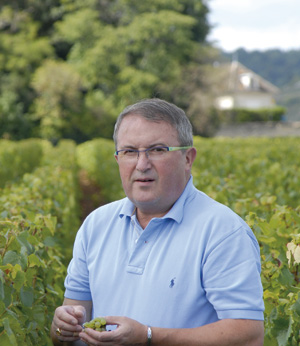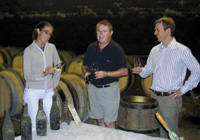Winegrower Burgundy
Château Génot-Boulanger
and the winegrowing-monks of CiteauxThe history of this domain sinks its roots back to the most ancient sources, to the Cistercian monks of Citeaux who, during the 12th century, were responsible for reviving the Burgundy winegrowing area, including of course Clos de Vougeot, now the emblematic, but not unique vestige of this period. We find ourselves in Meursault, in a castle, a real castle constructed during the 19th century in place of the outbuildings of Château de Citeaux.

The Génot family prospered in pharmaceuticals. Pharmacists were in fact the very first oenologists, since they alone were able to analyse foodstuffs and wine. Since 1974, this family business has been run by François Delaby, for whom vine growing is a form of art. Before taking over the management of this domain, he excelled as an interior designer, dealing with painting and design. It is in fact a family tradition: design, writing and art all working for the cause of wine. François Delaby is assisted by a team which includes a vineyard manager who supervises the domain’s 27.54 hectares and a consultant oenologist who masters Burgundy’s typical diversity. His daughter Aude and future son-in-law are members of the management team.
Like the majority of domains in Burgundy, the appellations of the same estate are scattered here and there in the area: over a distance of 60 km, 92 plots of vines (“climats”) are all part of the same domain. They are spread from Chambolle Musigny in the Côte de Nuits, to Mercurey in the Côte Chalonnaise. There are eighteen appellations for white wines, including a Great Growth and seven First Growths, and fourteen appellations for red wines, including two Great Growths and seven First Growths. Their names sing the praises of Burgundy: Chambolle Musigny, Clos de Vougeot, Cortons Charlemagne, Beaune Grèves, Pommard Clos blanc, Meursault les Bouchères, Puligny Montrachet Les Folatières or Chassagne Montrachet Clos Saint Jean and two First Growths in Mercurey. In addition, the domain also makes a Crémant de Bourgogne, with two thirds of Pinot and one third of Chardonnay. This extension to the range enables the firm to propose Burgundy wines to serve throughout an entire meal. Crémant offers excellent value for money.

Robert Tinlot: At the start of 2000, the economic crisis hit the French wine industry and subsequently other winegrowing areas around the world. With the impetus of the INAO’s President, René Renou, a motion to re-centre appellations of controlled origin on the notion of excellence was proposed, but the overall trend was to defend a brand policy and criticize the French system of AOCs, on the grounds that the consumer was completely confused by this system. So how do you manage with your 27 hectares of vines and 32 different appellations?
François Delaby : The economic crisis did not really affect fine wines. Our defence is in fact excellence. The name of our château combined with these different appellations is a sign of recognition for our customers who can choose from this diversity, but remain loyal to our chateau, because they know that we make our entire range of wines with the utmost care. This attention to detail is involved at all stages of production, from vine growing to bottling the wine. If grapes do not convey their origin, their terroir, winemaking is incapable of compensating for this lack of quality in the grapes and originality of the wine. For our vine growing, we use the method of supervised control. This means extremely regular monitoring for all our “climats”, so that we can intervene at the right moment and give the vine every chance to grow healthily. With supervised control, a considerable amount of time is spent observing the vines, but treatments are gradually fewer and lighter. This method also corresponds to protecting the environment. We give precedence to quality rather than quantity.

Château Génot-Boulanger
25, rue de Citeaux
21190 Meursault
Tel. : + 33 3 80 21 49 20
Fax : + 33 3 80 21 49 21
Email
With the pressure of competition from non-European countries, winemaking methods have become far more flexible. Modern winemaking now offers a wide range of possibilities. How do you make your decisions?
We adhere to traditions. Grapes are hand-picked. They are then sorted on a sorting table. We use a membrane pressing machine, which delicately presses. For red wines we de-stem 30% to 35%. Maturation is done in French oak barrels (Allier, Nièvre) which have been given an average level of toasting, and we use 25% to 35% of new barrels. Bottling is carried out on our premises with light filtration or even none at all. Wine must be treated with care, using gentle procedures. For sealing the bottles, we are loyal to cork. Our aim is to take into account the specific features of the various appellations, all produced by our own vines, enhance their true characteristics and satisfy the expectations of our connoisseur customers who know our wines well.Tell us about your customers.
In France we have an excellent clientele of top restaurants and we also attend some of the most highly acclaimed wine shows. This is where we meet our individual customers. Their number has doubled in the space of ten years; they are extremely loyal to our chateau. We do tastings in New York, where there are some really expert connoisseurs. 20% of our wines are exported to the USA and also the United Kingdom, Belgium, Switzerland, the Netherlands, Japan and Canada, particularly Quebec, and also China, to Peking and Shanghai. Brazil and Russia are emerging markets for our wines too. At our estate, we have not set up a sales cellar to welcome tourists, but we can receive our customers by appointment and organise tastings which are all the more convivial.
Robert Tinlot
Robert Tinlot


